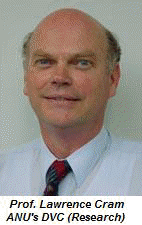 ANU
Tells Dr Nelson to Do His Homework -- but Ever So Politely. (April 21, 2005)
ANU
Tells Dr Nelson to Do His Homework -- but Ever So Politely. (April 21, 2005)
|
News & Views item - April 2005 |
![]()
 ANU
Tells Dr Nelson to Do His Homework -- but Ever So Politely. (April 21, 2005)
ANU
Tells Dr Nelson to Do His Homework -- but Ever So Politely. (April 21, 2005)
As the Minister for Education, Science and Training, Brendan Nelson, increasingly appears to be using the universities as a whipping boy to hone his political ambition, the Australian National University through its Deputy Vice-Chancellor (Research) physicist Professor Lawrence Cram (currently filling the role of Acting Vice-Chancellor) has risen to the minister's challenge that ANU is not contributing sufficiently to the Nation's economy and told him in effect he's dead wrong and why.
In a TFW March 18 Viewpoint Max Whitten published an open letter to Dr Nelson which began:
May I suggest that you, and those advisers you draw upon for inspiration, read a paper delivered by Australian, Richard Newton, who is Dean of the College of Engineering at the University of California, Berkeley, to the Australian Academy of Technological Sciences and Engineering in November 2002: Intellectual property creation, protection and dissemination in University - Industry - Government research collaboration – http://www.atse.org.au/uploads/Newton.pdf). The College of Engineering has created economic benefits worth trillions of dollars for the state of California, the United States and the world without depending on licence revenue as an indicator of good performance.
First it's worth noting that Professor Cram in his research has contributed to the disciplines of mathematics, physics, astronomy and engineering and has experience in research management at CSIRO, and the University of Sydney. He was Executive Director for Physics, Chemistry and Geoscience at the ARC from 2001 until 2004. Currently in addition to his duties at ANU he serves as a non-executive Director on four companies involved in the commercialisation of research. In short he would appear qualified to issue a rebuttal to Dr Nelson.
ANU undertakes fundamental research, informs government policy, advances Australian culture and creates technologies for Australian industry. The University's success in delivering results to the nation cannot be encapsulated in a single measure.
The Government itself has been grappling for some time with the problem of adequately monitoring the benefits that flow from university research.
The Coordinating Committee for Science and Technology has a working group looking at this matter. Their preliminary findings imply that indicators such as licensing income are not sufficient to provide a broad understanding of the commercial and economic impacts of Australian research.
For example, ANU solar energy technology is the basis for a $20 million investment by Origin Energy in a new photovoltaic manufacturing plant at Regency Park in South Australia. Origin, one of the largest photovoltaic retailers in Victoria and South Australia, is adopting ANU technology to lower production costs and prices.
In another example, the ANU Medical Genome Centre is the Australian cornerstone of the nation's largest biotech start-up company, Phenomix Australia. With $32 million funding secured in 2002, Phenomix Australia undertakes research at ANU into functional genomics for drug discovery and development.
ANU and its related company, Australian Scientific Instruments, earn millions of dollars in export income each year for high technology Australian instrumentation used world-wide in geoscience and astronomy. These earnings are not captured as licensing income, but they do represent value that ANU creates for the community.
ANU recently announced the formation of a $30 million venture capital fund with the Motor Trades Association of Australia and the ACT Government that aims to fund approximately 30 new ventures based on the University's research achievements.
ANU start-up companies are actively involved in exciting merger deals and initial public offerings in Australia and overseas. The new venture capital funds represent a strong vote of confidence by serious investors in the University's research strengths and capability.
It is important that the Australian community discusses the future of national icons such as ANU. In this context, the question of reducing the number of undergraduate places has been floated. At present, we have no plans to reduce undergraduate opportunities at this stage.
In fact, we aim to expose more of Australia's brightest young students to Australia's leading researchers at Australia's top university - and we are developing a range of new programs now, many of which will enable our undergraduate students to be involved directly in research.
Of course whether or not Dr Whitten's or Professor Cram's arguments are deemed of consequence rather depends on whether Dr Nelson wants to form a balanced view of how universities in general and ANU in particular contribute to the common wealth of the nation or is looking to scoring political points.
And whether or not Australians will be roused enough to care remains to be seen.